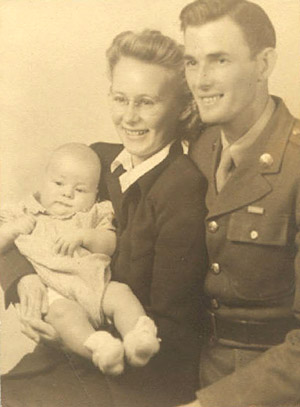
Courtesy James Summers

Remember...
Denvil Dale Summers
1917-1944
"It takes twenty years or more of peace to make a man; it takes about twenty seconds of war to destroy him."
United States Army Corporal Denvil Dale Summers, known to his family as "Dale" and to his comrades as "Denvil," was born August 21, 1917, at Advent, Jackson County, West Virginia. He attended grammar school there. Dale was the son of Leftridge Romeo Summers and Ida Virginia Jordan Summers, who had nine children: Ruby Myrtle Summers Hayes (1910-1937), Robert William "Bob" Summers (1913-1985), Audrey Summers (1916), Denvil Dale Summers (1917-1944), Faris Ray Summers (1920-2000), Eugene Odare Summers (1923-1951), June Geraldine Summers Torchio-Elliott (1925-2001), Camden Stafford "Staff" Summers (born 1929), and Hansford Iven "Hank" Summers (1932-2009).
Dale enlisted in the Army on June 26, 1940, in Kanawha County, West Virginia. While serving, he married Rosemary Harriet Cole on February 14, 1943, in Riverside, California. Rosemary was born on July 24, 1923, in Orting, Pierce County, Washington, the daughter of Elis Edward and Lillian Harriet Antrim Cole. Together, Dale and Rosemary had two children: Dale Ellis Summers and Virginia Jean Summers Rhine.
Dale lost his life during the Battle of the Bulge in World War II and was laid to rest at the Allied War Memorial Cemetery in the Grand Duchy of Luxembourg. Following his passing, Rosemary remarried around 1953 to Lloyd C. Barnett, who was born on November 5, 1923, to James W. and Bertha Bailie Barnett. Lloyd passed away on August 15, 2010. Rosemary passed away April 24, 2017, in Tacoma, Washington. She was buried in Orting Cemetery, Orting, Pierce County, Washington.
Dale was mortally wounded by shrapnel from a mortar attack at Beaufort. It is believed he was hit by a "Screaming Mimi" (or "Meemie") mortar barrage on the evening of December 19 or early morning of December 20.
His nephew, James Summers received an account of Dale's service from Paul Crucq, author of Strike, Fight, and Conquer: 60th Armored Infantry Battalion [Personnel List], August 1944 - May 1945 (Drukkerij Truijen, 1993). Crucq's research was corroborated by family members of Sgt. Roy Hojio, Dale's close friend, who recounted his wartime experiences. Dale and Sgt. Hojio had been friends before shipping out to Germany, strengthening the bond that would later define their service together.
According to these sources, Dale was sent alone as one of two messengers dispatched separately from Battalion Headquarters in Savelborn to reach the 1st Platoon and Anti-Tank Platoon of Company C, which had been surrounded by German forces since the start of the Battle of the Bulge on December 16. The other soldier who was sent did not make it, and his name remains unknown. Dale, however, successfully found the lost platoons.
Dale had written coordinates for a fallback position in case he located the lost units. To prevent enemy discovery, he hid the note between his helmet and helmet liner. Just prior to reaching the stranded soldiers, Dale was captured by German forces. As they marched him toward enemy lines, a scouting party from the lost platoons spotted the group and swiftly took action, eliminating the captors and freeing Dale.
Sgt. Roy Hojio, a member of Headquarters Company's Assault Gun Platoon, had also been captured near Beaufort but later escaped and joined the 1st Platoon and Anti-Tank Platoon of Company C. He recalled meeting Dale just after a mortar attack. As Hojio recounted:
"Just after one of those Screaming Meemie attacks, the lieutenant came over and told me a messenger had arrived with coordinates to reunite with our unit. The first thing I asked was, 'Is the messenger Cpl. Summers?' and he said yes, stating that Dale had asked, 'Is Sgt. Hojio here?' The lieutenant told him I was. Just after the lieutenant left, we were hit with another barrage, and then they were yelling for us to move out. The Germans were coming up the hill."
Hojio later asked about Dale's whereabouts and was told he had been hit and insisted the rest of the men continue without him. Battalion morning reports listed Dale as missing in action on December 20 and later confirmed his death on December 28.
A Stars and Stripes account described the heroic actions of the 60th Armored Infantry Battalion:
Nobody told the doughs of the 60th Armd. Inf. Bn. to pull out, so they stayed and fought until word finally got through to them. A few days later, they showed up in German helmets and with blankets draped over their shoulders, their rifles slung with bayonets fixed. They walked through German lines that way. . . . They kept right on going until they reached the U.S. lines. After that, they fought some more.
These soldiers were the soldiers that Dale and another soldier were sent to locate and relay the message to fall back to their unit in at Savelborn. Again this information was corroborated by family members of Sgt. Roy Hojio in recollections of his experiences.
The 60th Armored Infantry Battalion was renowned for its valor, earning a Presidential Unit Citation (PUC) for its stand at Echternach, Luxembourg, during the Battle of the Bulge. Dale's unit later helped open the road to Bastogne, where the 101st Airborne was besieged. The 9th Armored Division played a crucial role in halting the German offensive and subsequently advanced into Germany, capturing the Ludendorff Bridge at Remagen on March 7, 1945. This historic event allowed Allied forces to cross the Rhine, accelerating the push into Nazi Germany. A sign placed on the bridge read: "Cross the Rhine with dry feet courtesy of 9th Arm'd Div." This event was later depicted in the 1969 film The Bridge at Remagen.
James Summers, nephew of Denvil Dale Summers, researched his uncle's story and prepared this article.

West Virginia Archives and History welcomes any additional information that can be provided about these veterans, including photographs, family names, letters and other relevant personal history.